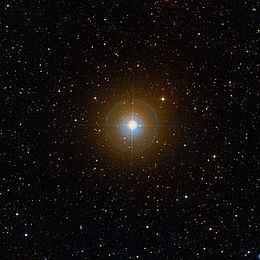Surface temperature 6,112 K Magnitude 4.22 Apparent magnitude (V) 4.22 | Radius 800,400 km (1.15 R☉) | |
 | ||
Mass 2.407 × 10^30 kg (1.21 M☉) Similar Delta Pavonis, Zeta Tucanae, Alpha Pavonis | ||
Gamma Pavonis (γ Pav, γ Pavonis) is a star in the southern circumpolar constellation of Pavo. With an apparent visual magnitude of 4.22, it is a fourth-magnitude star and thereby visible to the naked eye. From parallax observations with the Hipparcos satellite, the distance to this star has been estimated at 30.21 light-years (9.26 parsecs).
Compared to the Sun, this star has a 21% greater mass and a 15% larger radius. It is a brighter star with 152% of the Sun's luminosity, which is it radiating from the outer envelope at an effective temperature of 6,112 K. The stellar classification of F9 V puts it in the class of F-type main sequence stars that generate energy through the nuclear fusion of hydrogen at the core. It is a metal-poor star, which means it has a low abundance of elements heavier than helium. Age estimates range from a low of a billion years up to 7.25 billion years. Gamma Pavonis is orbiting through the Milky Way at an unusually high peculiar velocity relative to nearby stars.
This star has rank 14 on TPC-F's top 100 target stars to search for a rocky planet in the Habitable Zone, approximately 1.2 AU, or a little beyond an Earth-like orbit.
